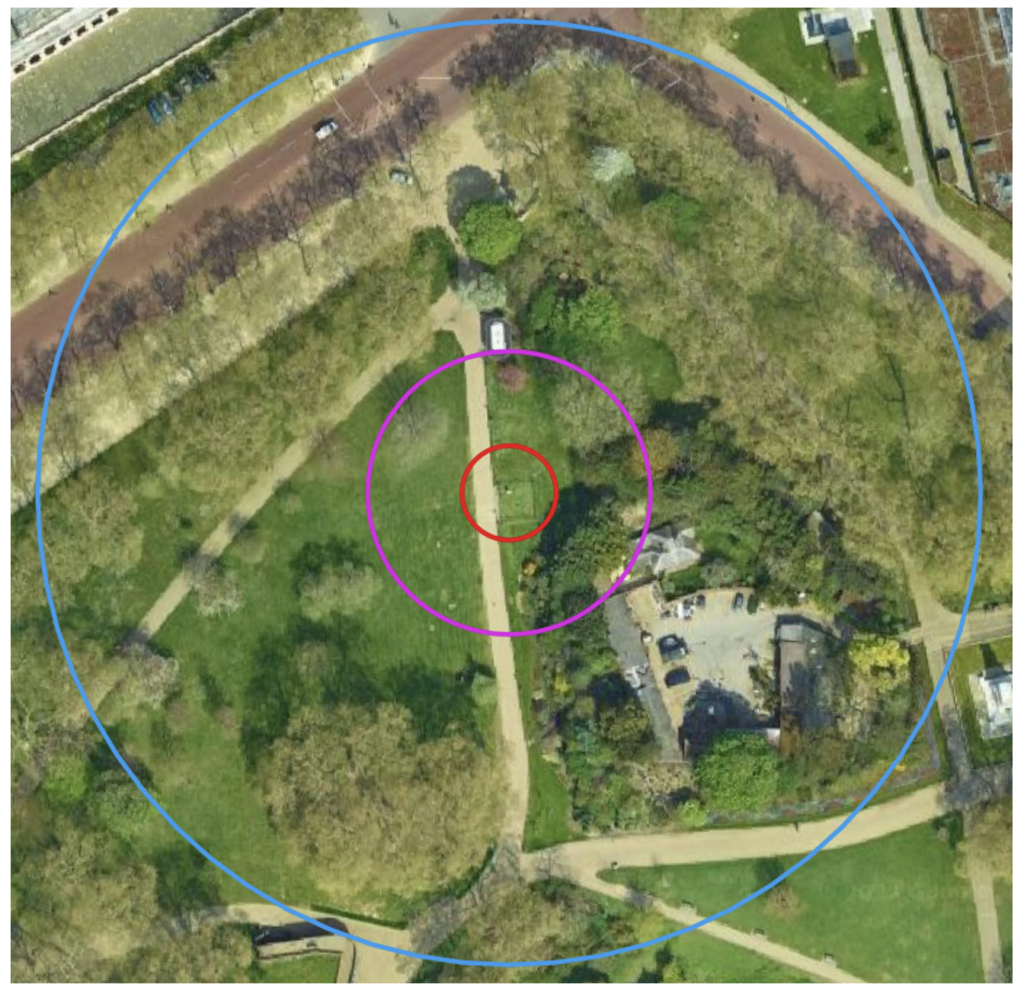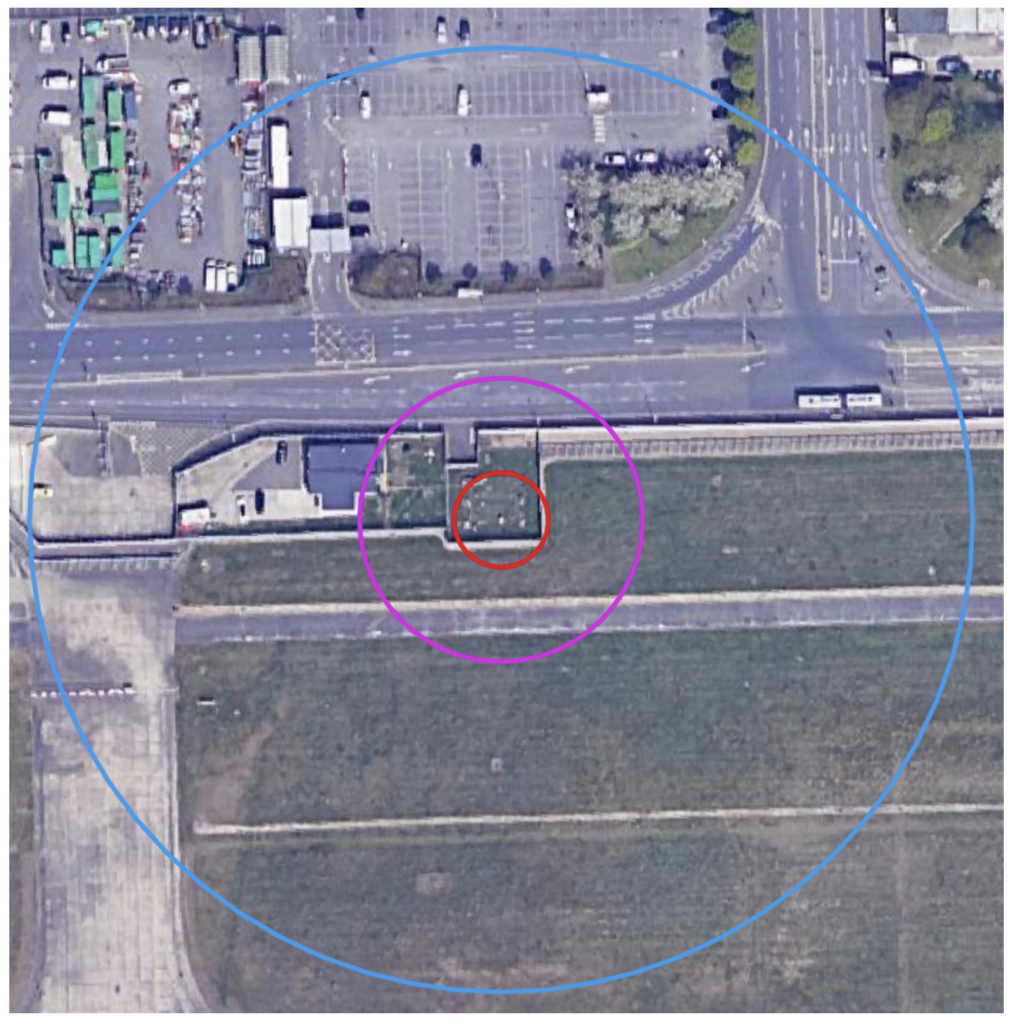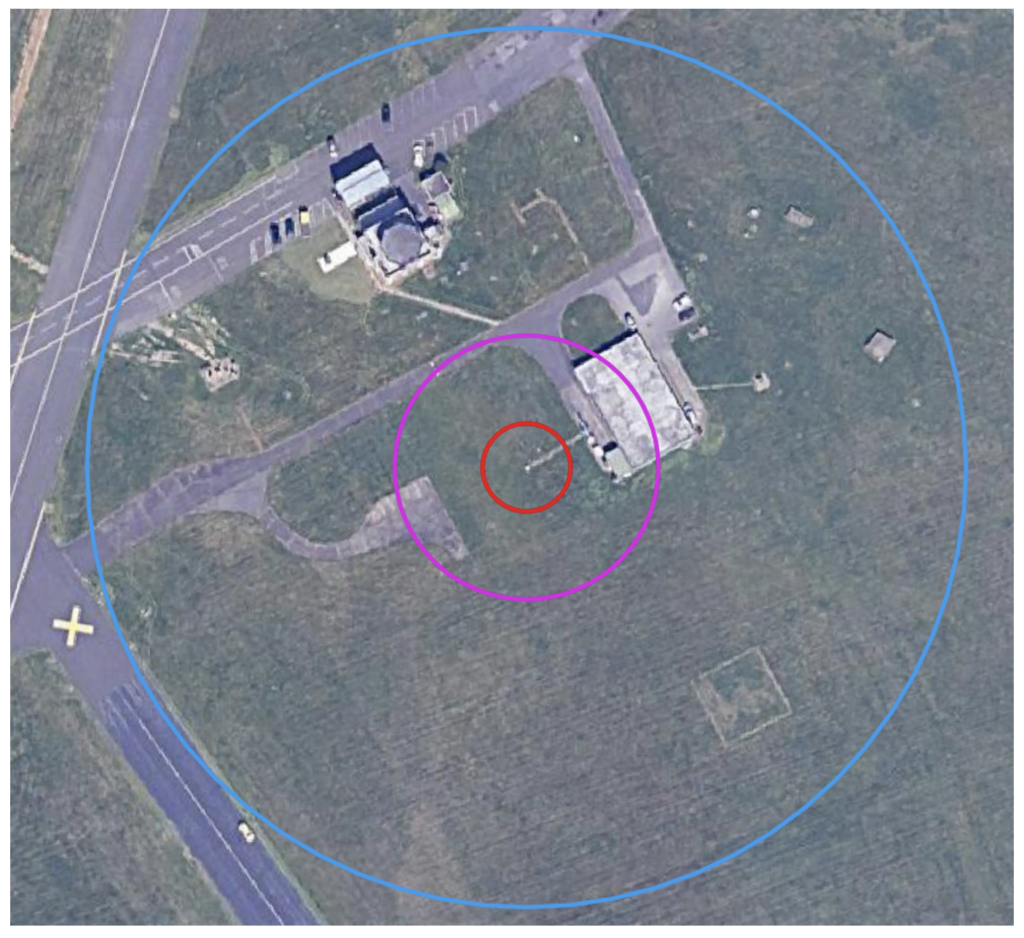Four of the five measuring stations that recorded temperatures over 40°C in the UK on the afternoon of July 19th last year are subject to margin of error uncertainties up to 1°C, according to classifications set by the World Meteorological Organisation (WMO). This includes the highest mark of 40.3°C set at RAF Coningsby. The second highest temperature of 40.2°C set in London’s St James’s Park has a suggested margin of error of up to 2°C. The findings are presented in recent research compiled by the climate sceptic blog Cliscep.
All five sites are shown to be subject to heat contamination from non-climatic sources. Finding Met Offices temperature sites that are not prone to such contamination is not easy, but Cliscep did note that one exists at Harpenden where there are no human-made structures within 100 metres. While Coningsby to the north in Lincolnshire produced the claimed record high, Harpenden topped out at 37.8°C.
The WMO has five weather station classifications. Class 1 and 2 do not require any adjustment of temperature, class 3 has estimated uncertainty of 1°C, while classes 4 and 5 are 2°C and 5°C respectively.
Regular readers will recall that we have raised concerns about the RAF Coningsby record due to nearby runways and buildings, and the presence of two squadrons of Typhoon fighter jets. The record was set at 3.12pm following a sudden jump in temperature of 0.6°C in the previous two minutes. Sixty seconds later, the temperature fell to 39.7°C. The Met Office has refused to answer our questions on the matter. We have also noted the wider debate about corrupted surface measurements that are increasingly evident in global temperature datasets. And we have also questioned whether these measurements should be accepted as part of the narrative used to promote the command-and-control Net Zero project.
Just days after the Daily Sceptic started asking questions about the Met Office Coningsby record, the BBC published an article that – without apparent irony – warned that “misinformation and myths about extreme hot weather are once again circulating on social media”. By ‘misinformation’ the BBC didn’t mean the Met Office’s claim that the U.K. had experienced record-breaking hot weather last July. On the contrary, the ‘misinformation’ it had in mind were claims that runway temperatures played a role in the ‘record’ temperatures, noting that some had suggested that heat emitted from an airport runway had skewed temperatures. The BBC didn’t dispute that the measuring devices are located in these concrete jungles, but said they are located in standardised boxes away from concrete or hardstanding “wherever possible”. That’s alright then.
Let us look at five photographs showing the placement of measuring devices in all the sites that recorded over 40°C on July 19th and see what care is taken to site them away from buildings and hardstandings.

Cliscep has marked three concentric circles at 10, 30 and 100 metres at RAF Coningsby, relevant to defining the WMO classification class. Coningsby is class 3 and subject to a margin of error up to 1°C. It fails class 2 because of hardstanding within the 30m radius.

No runways in St James’s Park, or fighter jets on manoeuvres, a point made on social media by those keen to promote the breaching of the 40°C mark. But the metalled path is within 10m, earning a class 4 classification with 2°C uncertainty. And it is bang in the centre of the largest city in the U.K.

Heathrow is often featured in the Met Office record books, but significant hardstanding within 30m earns a class 3 classification and a 1°C margin of error. Of course, Heathrow is also one of the busiest airports in the world and constant jet exhaust blowing over the site might suggest class 3 is a tad on the generous side.

The best of the lot, suggests Cliscep, is Kew Gardens with a class 2. There are artificial surfaces within the 30 and 100 metre rings. Cliscep doesn’t mention it, but the structure to the top left is one of the largest tropical greenhouses in the world. Breezes wafting over the glass structure could easily carry heat into surrounding areas of the gardens. It is noted that Kew is in the middle of a large urban area.

RAF Northolt suffers from all the usual airport corruptions with significant hardstandings within 30m of the measuring device. That makes it class 3, with a margin of error of up to 1°C.
Why does all this matter? Temperature measurements over the last 200 years have shown small overall increases – the trend over this period has been mostly positive, although there have been declines and pauses, the latest one stretching over eight years and counting. Over this period, meteorological operations have tolerated obvious inaccuracies and poor placements, knowing that the figures at least supply broad trends. That all changes, however, when humankind is suddenly driven into a doom-laden frenzy over worries that climate breakdown stalks the entire planet, following a rise of a few parts of a degree centigrade. In order to save the world, humankind is obliged to forgo cheap, efficient fossil fuels and embrace the green-controlled world of Net Zero. In those circumstances, temperature measurements become political tools. They must keep rising to keep populations scared and willing to fall in with unpleasant, de-industrialisation agendas.
That is why the 40°C ‘records’ of last summer were important. That is why there is an increasing disconnect between frequently adjusted surface records and accurate measurements made by satellites. That is why the BBC “debunks” the “common myth” that tarmac and concrete have a significant effect on nearby temperature measurements.
Chris Morrison is the Daily Sceptic’s Environment Editor.











To join in with the discussion please make a donation to The Daily Sceptic.
Profanity and abuse will be removed and may lead to a permanent ban.
Airfield runway temperature measuring sites are where they are for a reason. The engine performance and therefore the aircraft performance on take off needs to be calculated using the actual temperature of the air ingested by the engine, it doesn’t care how that temperature was created. If you’ve ever sat in a passenger aircraft in a hot part of the world waiting for the temperature to drop a degree to allow take off at the current aircraft weight, that’s why.
If you went 5 km out into the country, the temps were about 36C. Putting an electronic temp; reader, beside a greenhouse, airfield, highway, ventilator shafts, airplanes, cars, and in the midst of an urban area is not science but fraud. A bloody joke all of it.
The margin of error argument is a weak one. Margins of error can go either way, so the climate freaks could also claim the readings might be too low.
The fact that the measurements are taken next to sources of heat like airports and that the “record” readings were for only a few minutes, suggesting a heat blast, make for much more compelling arguments.
Are reasonably priced measuring devices available which store th rsulkts and / or output via (say) bluetooth for further analysis. I am sure many readers would be interested in helping with an alternative tmprature measuring exrcise, albeit with no history.
I have a system which cost less than £150 on-line. The key thing is that it links via my wifi to the Wunderground web site, recording all data every few seconds. I can view historical records of temperature, pressure, wind direction and speed, humidity and precipitation. It also has a map which shows similar stations in my vicinity so I can check whether my temperatures are consistent with others.
My system is mounted on a 5m pole some metres from the house.
Mine is made by Youshiko but others are available.
Ah yes —–Temperature. The first thing to mention is that all temperature is LOCAL You can record a temperature anywhere you put a thermometer at a given time. The second thing to mention is that temperature is not an amount of anything. It is a value. The third thing to mention is that adding two or more temperatures together and calculating some kind of “average” will give you a number, but that number is NOT a temperature. It is just a statistic. ————One more very important thing. We often here about “global temperature” or the “average global temperature”. But the Earth is not in thermal equilibrium so there is no single number that can represent the temperature of earth. So this idea from UN bureaucrats that we should try to limit global warming to 2C is absurd. There is an infinite amount of temperatures on earth and you can record one wherever you put a thermometer. The top of the mountain, the bottom of the ocean, high in the sky, low on the ground, under a tree, above a building, on a sheet of ice, under a sunbeam etc etc etc. ——Averaging all of those infinite amount of temperatures does not provide us with a temperature. It is just a mathematical construct. So ultimately there is no such thing as a “global temperature”. ————All of this is important when considering the alleged global warming (and the hundreds of billions spent on it). But it also reveals the absurdity of looking at a supposed 40C temperature at one place in time in one tiny area of the world somewhere in England and then trying to claim that this is an example of that alleged global warming, even if that temperature reading was 100% accurate, which it probably is not given the accuracy problems of thermometers in boxes that at one time a hundred years ago might have been in an empty field but now are surrounded by tarmac and concrete.
Hear bloody hear.
In my day job I take special time to explain and demonstrate the differences between data and information.
An average of n temperature readings from different locations isn’t a statistic, either. It’s a just number generated by applying an algorithm for reducing the amount of random error in subsequent measurements of a single quantity to a situation it isn’t suitable for as there’s no single quantity being measured. A temperature reading taken in my garden (Reading, Fobney Street) and a temperature reading taken somewhere in Antarctica are not two different approximations of the same quantity differing only in the amount of error in the value.
I call it a “statistic” or a “mathematical construct”. You choose to call it a “number generated by an algorithm………..”—-Ok fair enough , but one thing we can both say is that whatever that number is that is arrived at by doing an average, whether mean or median etc, it is NOT a temperature, and that is the main thing. Temperature is a Field.——— So when it comes to the alleged global warming there is no single number that represents the temperature of earth, and bureaucrats claiming they can regulate the earth’s temperature by tweaking some CO2 knob are pulling the wool over eyes for political purposes, but then you already know that.
The simplest analysis to prove the nonsense of so called climate science is the best and you have done that here. Well done! I would add try doing an experiment to prove that there is an average temperature. Take two cups of water at 50C and mix them together to get a total temperature – boiling water. That is the science of Greta and Attenborough.
Umberto Eco tenets of fascism:
The cult of action for action’s sake. “Action being beautiful in itself, it must be taken before, or without, any previous reflection. Thinking is a form of emasculation.”
Disagreement is treason. “The critical spirit makes distinctions, and to distinguish is a sign of modernism. In modern culture the scientific community praises disagreement as a way to improve knowledge.”
Fear of difference.
Selective populism. “There is in our future a TV or Internet populism, in which the emotional response of a selected group of citizens can be presented and accepted as the Voice of the People.”
Newspeak. “All the Nazi or Fascist schoolbooks made use of an impoverished vocabulary, and an elementary syntax, in order to limit the instruments for complex and critical reasoning.”
“humankind is suddenly driven into a doom-laden frenzy over worries that climate breakdown stalks the entire planet,”
I fail to see the point in adopting the language of idiots.
How can – climate break down?
Simplicity itself — imagine some moron^wclimate change experts predicts months of dry weather at the end of August and next week, it starts raining, raining and raining. That’s obviously a climate breakdown, ie, the climate ceased to function as it was supposed to.
🙂
Not to mention, there was an RAF Typhoon landing at that time give or take a minute. There were actually two flying together but the second one went around a few times and landed around 20 minutes later. The accuracy of the FlightRadar24 data isn’t so good at very low altitudes at all locations, so we can’t be precise on the exact landing time.
In Australia too, our Bureau of Meteorology has been busy moving temperature gauges to airports, expunging old unhelpful measurements from the record books (old high temperature records suddenly “disappear”), and changing the measurement goalposts, so that a 1 second temperature surge becomes the official daily maximum, rather than a 10 minute period.
And record cold temperatures are also “deplatformed”.
The temperature in our garden during the hottest part of last summer was 36.5c, which is bloomin’ hot, but quite a way off the touted 40c. We live in a rural area surrounded by farmland – not much tarmac!
Incidentally, I have had a fallout with a family member over ‘global warming’. Apparently I am a bad person because I ‘don’t believe’ in global warming (I wasn’t allowed to explain that it’s anthropogenic climate change that I doubt). This branch of the family are devoted and fully vaccinated and boostered covidians and are extremely woke (they thought digital currency and the possibility of carbon credits being connected to expenditure was a good idea). I find it funny, in a sad way, that you can know someone for nearly 70 years and then discover that a) you don’t know them at all, b) you have nothing in common and c)they are idiots. Yes, there is a ‘belief’ system with both global warming and covid, and, in the minds of some, denying their existence or seriousness is close to heresy. Bonkers.
The thermometer at the Cambridge Botanic Gardens was also used to claim 40C record and the previous year too I think. What is not mentioned is that the gardens house a large concrete building which is the Dept Of Biology and nearby is a major development of housing blocks near the station. None of those would have been there when the gardens were created but i bet no allowance has been made for this.
This is an interesting video I came across by accident on YouTube. A very reasonable discussion of the climate scare by a professor of climate science who gets no funding from the oil companies: https://youtu.be/qJv1IPNZQao
There is nothing new about this. All genuine scientists have been pointing this out for years. It doesn’t even need a science background, common sense is enough. Does anybody remember the Stevenson’s Screens in every park?